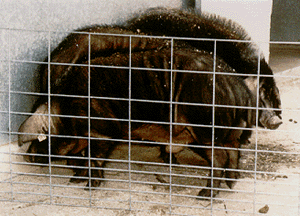Type the name of the breed you're looking for below
[wpdreams_ajaxsearchlite] Don't see the breed your're looking for? Click here and let us know!
Minzhu pig
| Place of Origin | United States |
| Origin | The Minzhu breed was introduced into the United Sates through a joint effort of the USDA, the University of Illinois, and Iowa State University. This effort was also successful in introducing Meishan and Fengjing pigs from China. This effort introduced a total of 144 pigs from these breeds into the United States. Iowa State University received 7 Minzhu males from this shipment on July 27, 1989. Minzhu pigs come from far northern China. They can be found in the Middle Temperate Belt, to the north of the Huaihe River Basin and the Qinling Mountains. The cold and dry climate of this region makes the Minzhu very tolerant to cold temperatures and harsh feeding conditions. They are also known as the Ming, Min, or Da Min. Minzhu is said to mean "folk pig." |
| Purpose | Meat |
| Characteristics | The breeds imported through this effort are slow growing and fat, but have a very good taste. They are considered to be resistant to diseases and are able to consume large amounts of roughage, farm by-products and other roughages being their main feed. Most are raised in pasture with limited concentrates. The Minzhu breed can be identified by its very long black hair. This hair has coarse, long bristles and a dense woolen undercoat in the winter. This hair allows sows to farrow in an open shed at 4° C with no problems. The body size of this breed is relatively large, with a narrow, level back and loin. Minzhu pigs are able to store 4.6 kg of body fat in the abdomen. Sows grow to be about 87.5 cm (34 in) high, 130 cm (51 in) around the chest, and 88.3 kg (195 lb) in live-weight. They have a backfat thickness of 3.2 cm and a dressing percentage of 72.2%. It is a prolific breed, though not as prolific as the other breeds imported. They reach puberty at 3-4 months of age, achieve high embryo survival rates, and a large litter rate of 15-16 pigs. Third and later parities of this breed had 15.5 pigs born, with 11.0 being weaned. Their 240 day weight was 233.9 lb (106 kg), with an ADG of 1.10 lbs. |



